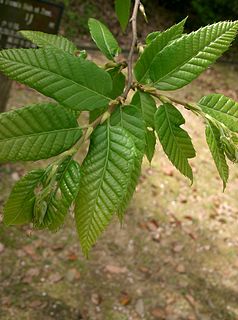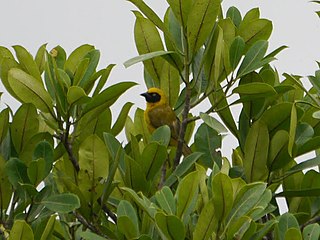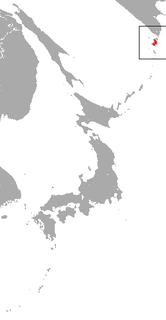
Amphibola crenata is a species of air breathing snail with an operculum, a pulmonate gastropod mollusc which lives in a habitat that is intermediate between the land and the sea, not entirely terrestrial and not entirely marine. This is not a true land snail, but it is also not a true sea snail. Unlike almost all other snails that have opercula, this species breathes air. It is common in New Zealand.

Castanea crenata, known as Korean chestnut, Korean castanea, and Japanese chestnut, is a species of chestnut native to Japan and Korea. Castanea crenata exhibits resistance to Phytophthora cinnamomi, the fungal pathogen that causes ink disease in several Castanea species. The mechanism of resistance of Castanea crenata to Phytophthora cinnamomi may derive from its expression of the Cast_Gnk2-like gene.

Miconia crenata,, commonly called soapbush, clidemia or Koster's curse, is a perennial shrub. It is an invasive plant species in many tropical regions of the world, creating serious damage.

Notiosorex cockrumi, also called Cockrum's gray shrew or Cockrum's desert shrew, is a tiny species of shrews named in 2003. This red-toothed shrew, which is as light as a penny, is the first new mammal species from Arizona since 1977. Its range extends from Arizona to central Sonora, Mexico.

A species that is extinct in the wild (EW) is one that has been categorized by the International Union for Conservation of Nature as known only by living members kept in captivity or as a naturalized population outside its historic range due to massive habitat loss.

Fagus crenata, known as the Siebold's beech, Japanese beech, or buna, is a deciduous tree of the beech genus, Fagus, of the family Fagaceae.
Stevia anisostemma is a species of flowering plant in the family Asteraceae. It is found only in Ecuador. Its natural habitat is subtropical or tropical moist montane forests. It is threatened by habitat loss.
Stevia bertholdii is a species of flowering plant in the family Asteraceae. It is found only in Ecuador. Its natural habitat is subtropical or tropical moist montane forests. It is threatened by habitat loss.
Stevia dianthoidea is a species of flowering plant in the family Asteraceae. It is found only in Ecuador. Its natural habitat is subtropical or tropical moist montane forests. It is threatened by habitat loss.
Stevia tunguraguensis is a species of flowering plant in the family Asteraceae. It is found only in Ecuador. Its natural habitat is subtropical or tropical moist montane forests. It is threatened by habitat loss.

Bannerman's weaver is a species of bird in the weaver family, Ploceidae. It is found in Cameroon and Nigeria. Its natural habitat is subtropical or tropical moist montane forests. It is threatened by habitat loss.

The long-footed shrew is a species of mammal in the family Soricidae. It is found in Cameroon, Central African Republic, Republic of the Congo, Democratic Republic of the Congo, Equatorial Guinea, and Gabon. Its natural habitat is subtropical or tropical moist lowland forests.

The Paramushir shrew is a species of mammal in the family Soricidae. It is endemic to Russia. Its natural habitat is temperate forests. It is threatened by habitat loss.

Day's shrew is a species of mammal in the family Soricidae. It is endemic to India. Its natural habitat is subtropical or tropical dry forests. It is threatened by habitat loss.

Aeshna crenata, the Siberian hawker, is a species of dragonfly in the family Aeshnidae. It is found in Belarus, Finland, Latvia, Lithuania, and Russia.
Eugenia crenata is a species of plant in the family Myrtaceae. It is endemic to Jamaica. It is threatened by habitat loss.
Melanophylla crenata is a species of plant in the Torricelliaceae family. It is endemic to Madagascar. Its natural habitat is subtropical or tropical moist lowland forests. It is threatened by habitat loss.
Rinorea crenata is a species of plant in the Violaceae family. It is found in Costa Rica and Panama.

Xylosma crenata, the sawtooth logwood, is a species of flowering plant in the willow family, Salicaceae, that is endemic to the island of Kauaʻi in Hawaii. It is a tree, reaching a height of 46 ft (14 m). Sawtooth logwood inhabits montane mesic forests dominated by koa and ʻōhiʻa lehua at elevations of 975–1,065 m (3,199–3,494 ft). It is threatened by habitat loss.
Conturbatia crenata is a species of air-breathing land snail, a terrestrial pulmonate gastropod mollusk in the family Streptaxidae. It is the only species in the genus Conturbatia.












